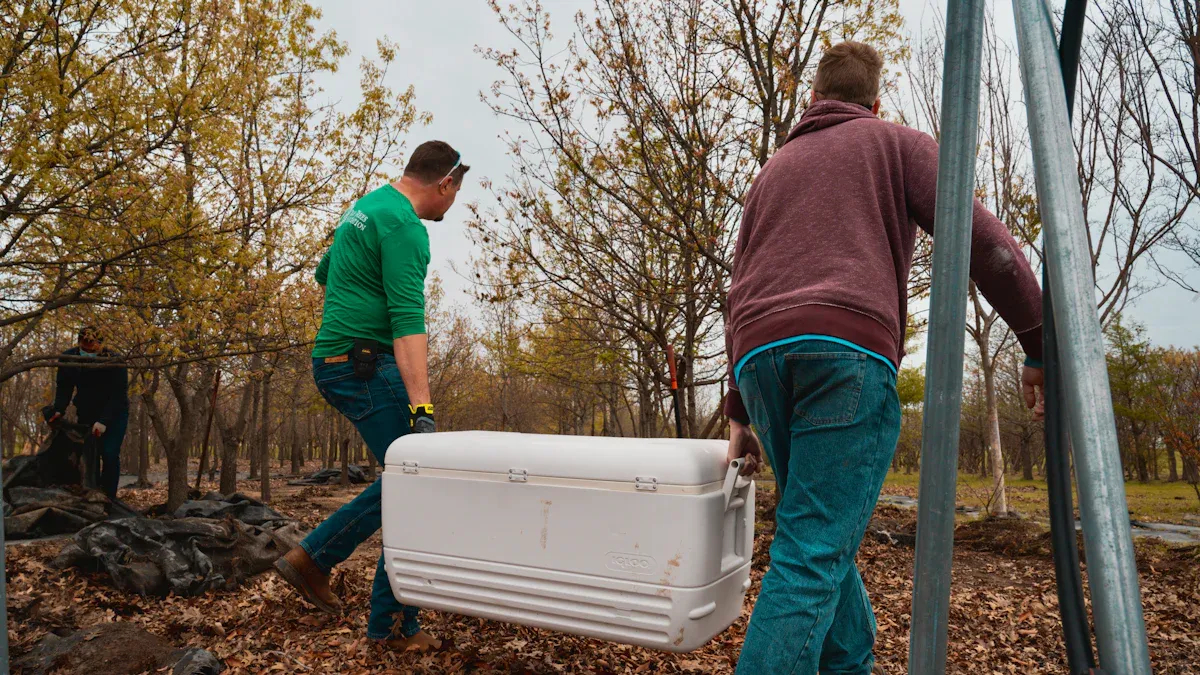Walk in cooler hacks everyone’s talking about now

Ready to save big on your next walk in cooler project? You can build a walk-in cooler without breaking the bank, and people everywhere are talking about these clever tricks. Try using a simple air gap, lightweight trays, or even a waik in cooler made from old containers. You do not need fancy tools. Just a bit of creativity and you will have a cooler that works great and saves you money.
Key Takeaways
Pick a good spot and size for your walk-in cooler. This helps you avoid problems later. Measure your area first. Think about how much you might need in the future.
Use light materials like pine or plastic trays for the cooler frame. This makes building easier. It also saves money.
Add a 2-inch air gap around your cooler. This helps air move better. It can lower energy bills. Seal up any cracks to keep it working well.
You can use shipping containers to make a strong cooler fast. Make sure you add enough insulation. This keeps the temperature steady.
Try cheap insulation like foam panels or old blankets. These help your cooler stay cold. You do not have to spend a lot.
Walk-in cooler planning essentials
Choosing location and size
Picking the right spot for your walk-in cooler can save you a lot of trouble later. You want a place that is easy to reach and has enough space for your needs. Here’s a simple way to plan:
Measure your space. Make sure you know the exact size of the area. Leave room for air to move and for deliveries.
Think about how much you need to store. Plan for busy times and future growth.
Choose doors that fit your layout. Sliding or swinging doors can help you organize better.
If you live in a hot or cold state, your location matters even more. Check out this table to see how climate can change your cooler needs:
Zone | Example States | Average Winter Low (°F) | BTU Multiplier |
|---|---|---|---|
1 – Warm | FL, TX, AZ | 40–50°F | × 0.8 |
2 – Moderate | TN, NC, VA | 30–40°F | × 1.0 |
3 – Cold | MI, OH, PA | 20–30°F | × 1.25 |
4 – Very Cold | MN, ND, ME | 0–20°F | × 1.5 |
5 – Extreme Cold | MT, AK | Below 0°F | × 1.75 |

Setting your budget
You do not need to spend a fortune to get a great walk in cooler. Start by looking at your must-haves. Energy-efficient models can cost more at first, but they save money over time. Look for coolers with LED lights and good insulation. These features lower your bills and keep your food safe.
Air gap and airflow tips
Don’t forget about airflow! Leave a 2-inch air gap around your cooler walls. This helps stop mold and keeps the air moving. Good insulation can also cut your energy use by up to 30%. If you skip this step, you might lose a lot of cold air and waste money. Keep things simple and safe by planning for airflow from the start.
Tip: Always check for leaks or blocked vents. A little maintenance goes a long way!
Budget materials and frame hacks
Lightweight wood and plastic trays
You do not have to use heavy or pricey materials for your cooler frame. Pine and fir are good choices for most home projects. These woods are light and easy to cut. You can move them without much effort. You do not need special tools to build with them. If you want something even lighter, try strong plastic trays. People use plastic shelving or food-grade trays for shelves and supports. These trays do not get damaged by water or mold. This helps your cooler last longer.
Tip: Make sure your wood or plastic is clean and dry before you start. Wet materials can cause mold or bending.
Repurposed shipping containers
Have you thought about using a shipping container for your walk-in cooler? Many people like this idea because it saves money and time. Shipping containers are strong and can handle bad weather. You can move them easily. You can set one up in your yard or business lot in a day or two.
Here’s a quick look at the good and bad sides:
Advantages | Disadvantages |
|---|---|
Saves money and can be changed | Not much space in each container |
Strong and handles weather well | Problems with insulation and moisture |
Good for the environment | Rules and codes may limit use |
Fast to set up and move | Costs more to change or add features |
If you use a shipping container, add more insulation. Containers can get hot or cold very fast. You need to keep the cooler at the right temperature. You should also check local rules before you start. Some places have special rules for containers.
Sourcing cheap materials
You can find cheap materials for your walk-in cooler online or in your town. Restaurant supply stores often sell used or extra items for less money. You can also look at auctions for deals on coolers, doors, and shelves. For example, some auctions sell Norlake coolers and freezers for much less than new ones.
Here are some places you can look:
You might find all you need at one of these auctions, like panels and doors. Always check items before you buy them. This way, you know they will work for your project.
Note: Ask hardware stores if they have extra insulation or wood. Sometimes you can get these for free or for a very low price.
Building a walk-in cooler step by step

Ready to roll up your sleeves? You can tackle building a walk-in cooler with a little planning and some smart shortcuts. This step-by-step guide will help you save money and avoid common mistakes. If you get stuck, check out DIY videos online. Watching someone else build a cooler makes things much easier to understand.
Framing and assembly shortcuts
Start with the frame. You want it strong but not heavy. Use pine or fir boards for the walls and ceiling. These woods are easy to cut and move. Lay out your boards on the ground first. This helps you see if everything fits before you start screwing things together.
Here’s a quick list to keep you on track:
Measure each board twice before you cut.
Use corner brackets to hold the frame steady.
Try a drill with a screwdriver bit. You can work faster and save your hands.
Build the frame in sections. Move each section into place and connect them.
Tip: Ask a friend to help you lift and hold boards. You can finish the frame much faster with two people.
DIY door solutions
You do not need a fancy door for your cooler. You can build one yourself with plywood and foam insulation. Cut the plywood to fit your opening. Glue foam panels to the inside. Add weatherstripping around the edges. This keeps cold air inside and blocks drafts.
If you want a swinging door, use strong hinges and a latch. For sliding doors, you can use a barn door kit. These kits are easy to install and do not cost much. Make sure your door closes tight. You do not want warm air sneaking in.
Here’s a simple door plan:
Material | Purpose | Where to Get It |
|---|---|---|
Plywood | Door surface | Hardware store |
Foam panels | Insulation | Home improvement store |
Hinges/latch | Door movement | Online or local store |
Weatherstrip | Seal edges | Hardware store |
Note: Test your door before you finish. Open and close it a few times. Make sure it does not stick or leave gaps.
Sealing and weatherproofing
Now you want to seal your cooler. Use caulk or spray foam to fill every crack. Pay close attention to corners and where the walls meet the floor. Water and air can sneak through tiny spaces. Sealing these spots keeps your cooler cold and dry.
Weatherproofing is easy. Cover the outside walls with plastic sheeting or waterproof paint. This stops rain and moisture from getting inside. If you live in a wet area, add extra layers. You can use a staple gun to attach plastic sheets quickly.
Here’s a quick code block for sealing tips:
1. Check all seams for gaps.
2. Apply caulk or spray foam to each gap.
3. Smooth out the seal with a gloved finger.
4. Let it dry before you add insulation.
Callout: Good sealing means lower bills and less work later. You will not have to fix leaks or fight mold.
You can finish building a walk-in cooler in a weekend if you follow these steps. Take your time and double-check each part. Your cooler will last longer and work better.
Cooling and insulation hacks

Affordable cooling systems
You want your walk in cooler to stay cold. You do not have to spend a lot of money. You can make a cooling system with things from home. Here are some ideas people like:
An electric fan moves air and helps cool things down.
Ice or frozen bottles add cold air inside the cooler.
Styrofoam coolers or cardboard boxes help direct cold air.
Plastic tubing or hose can send air to different spots.
These ideas work well for small coolers. You do not need fancy equipment. You can set up your cooler in a few hours.
Energy-saving tips
Saving energy helps you save money. You want your cooler to use less electricity. Here is a table that shows how cooling systems compare:
Cooling System Type | Energy Efficiency | Initial Cost Consideration |
|---|---|---|
Energy-efficient air conditioning | High efficiency, uses less energy | Costs more at first, saves money later |
Passive cooling techniques | Uses little energy, uses natural airflow | Costs very little, depends on your home |
Evaporative cooling systems | Very efficient, works best in dry places | Costs less than AC units |
You can save more energy by using LED lights. Keep the door closed as much as you can. Check for leaks around the door and walls. If you find gaps, seal them right away. Your cooler will stay cold longer and use less power.
Tip: Clean your fan and cooling system every month. Dust and dirt make your cooler work harder and use more energy.
Low-cost insulation tricks
Insulation keeps cold air inside your cooler. You do not need expensive materials. You can use foam panels, old blankets, or bubble wrap. Cut foam panels to fit the walls and ceiling. Tape them in place for a tight seal. If you have extra blankets, hang them over the door at night. Bubble wrap works well for small gaps.
Here is a simple code block for a DIY insulation plan:
1. Measure each wall and ceiling.
2. Cut foam panels or bubble wrap to size.
3. Tape or glue panels to the inside surfaces.
4. Check for gaps and fill with extra material.
You will notice your cooler stays cold with less work. You will save money on your bills when you add insulation.
Safety, maintenance, and real-life wins
Keeping your walk-in cooler safe
You want your walk-in cooler to be safe for everyone. First, check that the door locks work. Make sure the lights turn on. If you have a refrigeration unit, keep space around it clear. This helps stop accidents and lets air move well. Always put a thermometer inside the cooler. You can see problems early if the temperature changes. If you see ice or water inside, check the refrigeration unit fast. Good safety keeps your food safe and protects your money.
Tip: Place a non-slip mat at the door. This helps stop slips when the floor is wet.
Easy maintenance
You can keep your cooler working well with simple steps. Taking care of your refrigeration unit is important. Here are some things you should do:
Clean the coils and filters every month.
Check the refrigerant levels and pressure often.
Look at the door seals and gaskets for cracks.
Calibrate the thermostats and sensors for good readings.
Make sure water drains and defrosts right.
Tighten any loose wires or connections.
Lubricate the motors and fans to keep them quiet.
Test the temperature to make sure it is right.
If you do these things, your cooler will last longer. You will save money on repairs and keep your food safe.
Success stories
Many people have built walk-in coolers with easy hacks. A small bakery used a simple refrigeration unit and foam panels. They saved a lot of money and kept pastries fresh. A farmer made a cooler from a shipping container and a used refrigeration unit. He keeps vegetables fresh for weeks. A restaurant owner got a new energy-saving refrigeration unit. Her bills went down, and her cooler stayed cold in summer.
Callout: You can build a walk-in cooler that fits your needs. With the right refrigeration unit and some care, you save money and keep food fresh.
You now know the best walk-in cooler hacks everyone’s talking about. Here’s a quick recap:
Use lightweight wood or plastic trays for easy framing.
Repurpose shipping containers for fast, sturdy builds.
Add a 2-inch air gap and seal every crack.
Try low-cost insulation and simple cooling tricks.
You can build a walk-in cooler on a budget. Start your project today!
Have a hack or story to share? Drop your tips in the comments. Your idea could help someone else save big! 🚀
FAQ
How cold can I make my DIY walk-in cooler?
You can usually keep your cooler between 35°F and 40°F. Use good insulation and a reliable cooling unit. Check the temperature often with a thermometer. If you need it colder, upgrade your cooling system.
What is the cheapest way to insulate my walk-in cooler?
You can use foam panels, bubble wrap, or even old blankets. Tape or glue them to the walls and ceiling. Fill any gaps with spray foam. This keeps cold air inside and saves you money.
Can I use a regular air conditioner for cooling?
Yes, you can use a window AC unit with a CoolBot controller. The CoolBot tricks the AC into cooling lower than normal. This setup works well for small walk-in coolers and costs less than commercial refrigeration.
How do I stop mold and moisture inside my cooler?
Keep a 2-inch air gap around the walls. Check for leaks and seal them. Use a small fan to move air. Clean the inside often. These steps help prevent mold and keep your cooler dry.
See Also
Maximize Your Walk-In Chiller's Efficiency With These Tips
A Complete Guide to Selecting the Right Walk-In Cooler
Overcoming Storage Issues With a Restaurant Cold Room

